Solar Panels
Introduction to solar panel systems
Note: ‘Solar panels’ is a term that refers to both solar thermal panels which generate hot water and also solar photovoltaic panels that generate electricity. In these pages we are looking specifically at solar photovoltaic panels – also known as solar pv panels and sometimes known as solar modules.
 Installing solar photovoltaic (PV) panels is one of the easiest ways to significantly reduce your electricity consumption (and therefore energy bills) as well as providing your home or business with an income through the government's feed-in tariff scheme.
Installing solar photovoltaic (PV) panels is one of the easiest ways to significantly reduce your electricity consumption (and therefore energy bills) as well as providing your home or business with an income through the government's feed-in tariff scheme.
Well designed, quality solar PV systems should be lasting at least 20-30 years with the inverter needing to be changed after around 10-15 years. Solar photovoltaic systems are now a mature and reliable technology with great internet enabled monitoring systems to allow detailed monitoring over time. Because the system will be in operation for so long it is important to choose and install high quality equipment that will perform well for years to come.
Installing solar PV panels also helps to protect you and your family or business, against future energy price rises. This is because if you are consuming electricity on-site in your home or commercial property during the day, like most homes and businesses will be, you will be using your own self-generated electricity from the solar PV panels and therefore will not have to pay your electricity supplier for this electricity. If electricity bills rise in future you will still be generating your own electricity that you will not need to purchase from the electricity suppliers. By installing solar panels you could, through a combination of savings and additional earnings through the Smart Export Guarantee (SEG), be £100’s or even £1000’s a year better off.
If you are thinking about installing a solar energy system please feel free to contact Exeo Energy today for expert professional advice.
How do the solar panels save you money?
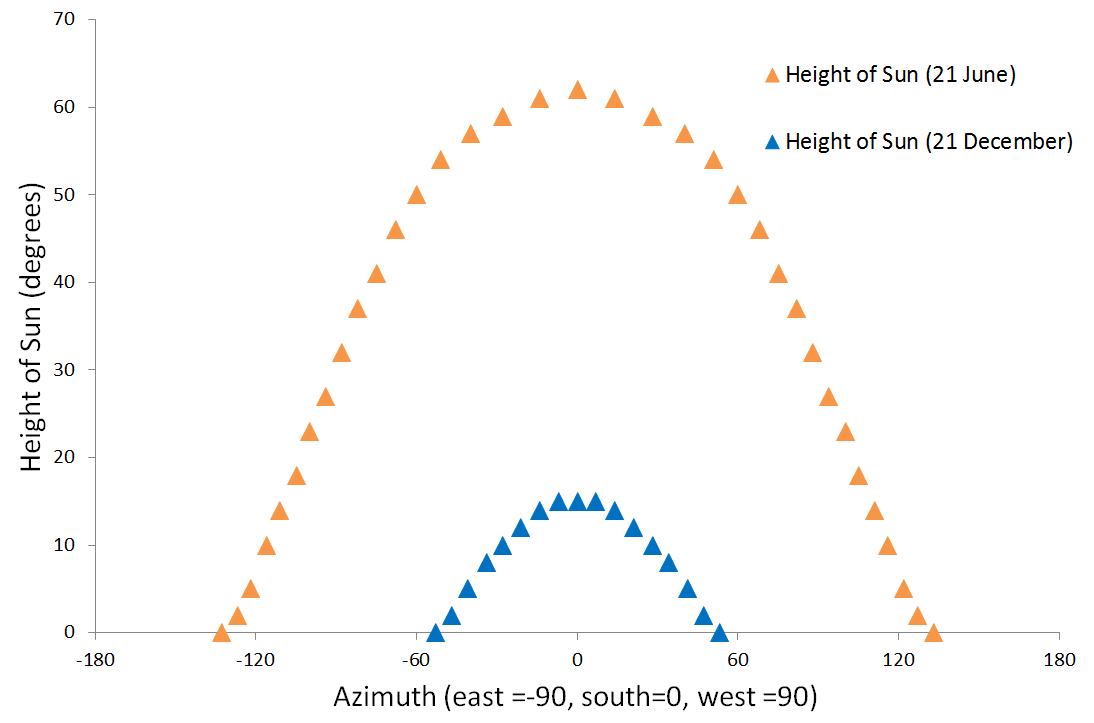 As soon as it gets light in the morning solar cells in the panels start to generate electricity. You get paid for generating this electricity and you can still use it yourself, thus reducing your electricity bill.
As soon as it gets light in the morning solar cells in the panels start to generate electricity. You get paid for generating this electricity and you can still use it yourself, thus reducing your electricity bill.
In the UK, somewhere like Oxford, in the summer the system might generate electricity from 5am to 9pm, and in the winter from 8am through till 4pm. In Landsend or John‘OGrotes you will have a slightly different situation. The electricity generation from the solar photovoltaic cells will rise as the energy from the sun increases during the middle of the day and then drops off again in the afternoon to the evening as the energy from the sun reduces. Whether the day is clear and bright or overcast and dull will make a big difference to the daily electricity generation. So the amount of solar electricity will vary a lot from day to day and from season to season. However if we know a few key bits of information we can estimate pretty accurately how much electricity the solar power system will generate every year. The key information we need to know to calculate this are:
Geographically where will the solar modules be installed – this can make a big difference to the amount of available energy e.g. Cornwall or Scotland, or internationally Norway or Nigeria
What angle the solar modules will be mounted at from the horizontal – if the modules are roof mounted this will normally be the same as the roof angle. The ideal angle in the UK is around 30-35 degrees which happily is similar to most roof pitches.
What angle the solar modules will be pointing from South. i.e. will the panels be facing directly south (best!) at 0 degrees; South-East or South-West at 45 degrees or East or West at 90 degrees. The angle from south could of course be anything, and will normally be restricted by the an existing building, but we have to know what it is to withing around 5 degrees. The angle from south is referred to to as the azimuth.
Are there any shading issues? Will the solar photovoltaic modules be in the shadow of any nearby buildings or trees? If so we will need to use a device to measure the extent and the likely effect of the shading on the system.
The size of the solar panel system in kWp – this could be dictated by the size of the available suitable roof area, or it could be sized to for National Grid restrictions or to suit a clients budget or energy demand.
The two charts below give an indication of what to expect from solar generation during summer and winter on both clear (orange) and overcast (blue) days. The graphs are for a 4 kWp system that does not suffer from any shading.
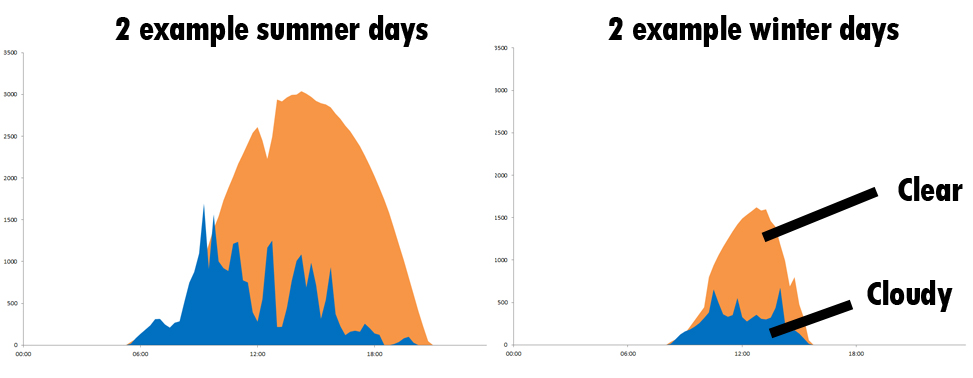
How much electricity will I save by installing solar pv panels?
This all depends on how much electricity you are using during the day at the moment. Almost all properties, whether domestic or commercial, will have some sort of electrical base-load being consumed all the time in the background 24/7. This is normally made up of:
fridges
freezers
things left on standby like TV’s, printers, etc
heating controls
In some properties this may be as low as 50-100 W being used continuously. Other properties could well be using as much as 500 W or maybe even more. An interesting activity to carry out is to get a handheld energy monitor and to wander around your property switching things off trying to get the energy meter to read zero. It is surprising how many electrical appliances there are consuming electricity in the background.
If you have a large consumption of electricity your potential to save is significantly more than if your consumption during the day is very small. However if your consumption is small there are things you can do to make sure you get the most out of your solar PV system and therefore reduce your electricity bills. This includes:
Switching your flexible loads on when the sun is shining – a good example is the washing machine – set it on a timer to come on at say 11am on a sunny day if you are in work and you will be doing your washing for free. If you do this all year it will make a significant difference to your bills.
Installing a device which can divert any spare electricity to a hot water immersion heater.
Installing a solar battery storage system
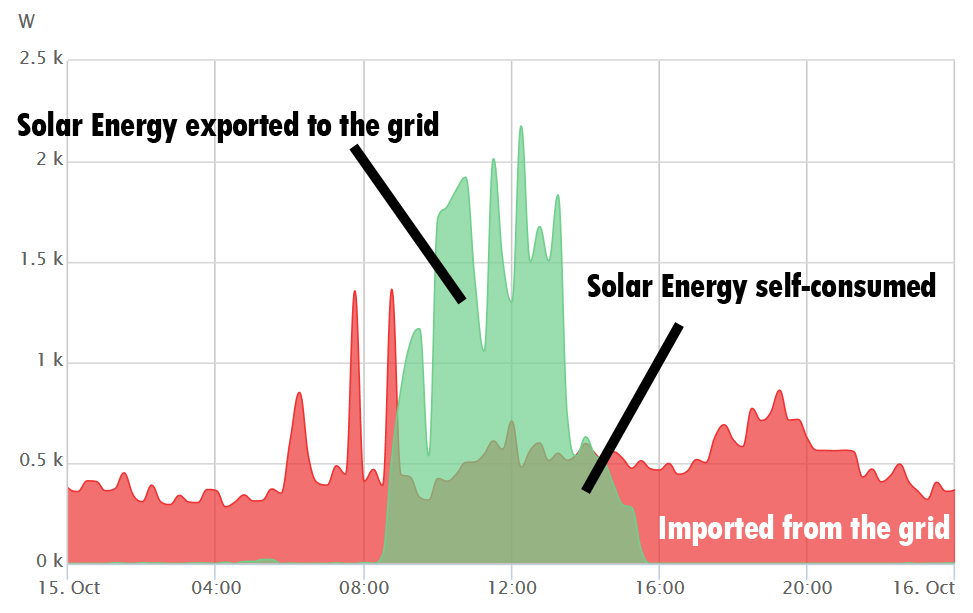
How much of your solar electricity you self-consume on site makes a big difference to what your return will be from the solar PV system so if you are looking to install solar panels it makes sense to get a good feel for how much energy you consume and also what the electricity consumption profile looks like over a day. This will help Exeo Energy to provide you with more accurate estimates of how the system will perform.
Will I still need to buy electricity if I have solar panels installed?
Unfortunately solar photovoltaic cells only generate during the day and your electricity consumption is normally spread out over a full 24 hour period. Therefore during the night you would still have to buy electricity from your supplier. There are now solar panel battery systems available that will store excess electricity during the day which can then be used in the evening. However even with batteries you would still normally be connected to the national grid and you would still need to purchase energy most days, especially in the winter. As you might expect there is a big difference between generation in the summer months and the winter months.
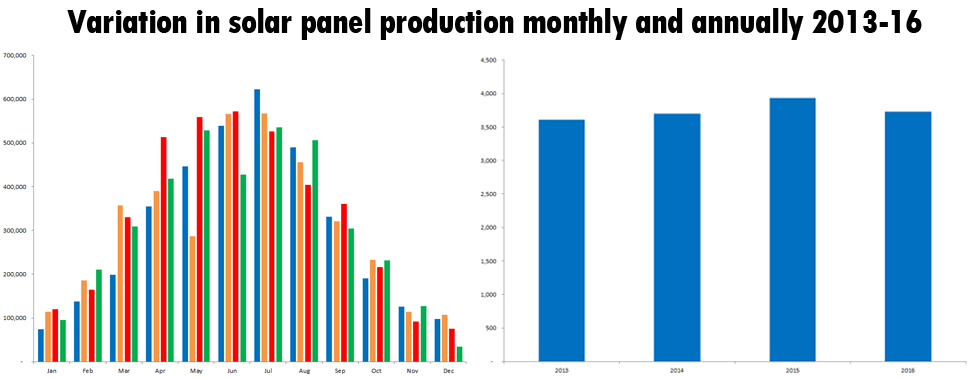
How does a solar panel installation work?
During daylight hours light particles from the sun called photons hit the cells of a solar photovoltaic panel. This causes an electro-chemical process which results in an electric current being created by the solar cells, the brighter the sunshine the more electrical energy is created. Having a number of solar panels connected together creates a significant amount of electrical energy. This electrical energy is created as DC (Direct Current) electricity, the same as the kind of electricity found in batteries. However our homes and offices, and the national grid, use AC electricity (Alternating Current). Therefore the DC electricity from the solar panels has to be converted into AC electricity that can then be used in the house by household appliances and also any excess energy generated can be exported to the national grid to be used by other properties in the neighborhood.
For a more in-depth look at this please read our article 'How do solar panels work?'
or take a look at this Live Science article.
Is a solar installation right for me and my property?
If you own your own home or commercial premises, use electricity and have somewhere suitable and the availible space to mount them, then installing a PV system is normally something worth considering. Based on a desktop study or for more accuracy a site survey, Exeo Energy can let you know how much energy you would likely generate from the solar PV system, and therefore how much income you would get through the feed-in tariffs and we can make estimates of how much energy you could save. You then have all of the information you need to decide if solar panels are a good option for you. Our approach is to be as open, straightforward and transparent as possible providing you with as much clear and concise information about the solar pv installation as possible. We have many years of experience in designing and installing systems and we use this to choose and install the best solar panel systems for our customers. We design system that we know are going to be performing well for years to come.
If you would like a chat with our experts about how a solar installation might benefit you please get in touch with us today.
What do different pv panels look like?
From an aesthetic perspective there are a number of different types of solar photovoltaic module:
Silver framed modules– often with blue cells
Black framed modules – with blue or black cells
All-black modules
It terms of actual performance (electricity generation) there is not much difference over a year but it terms of aesthetic there can be a big difference. See the photos below:
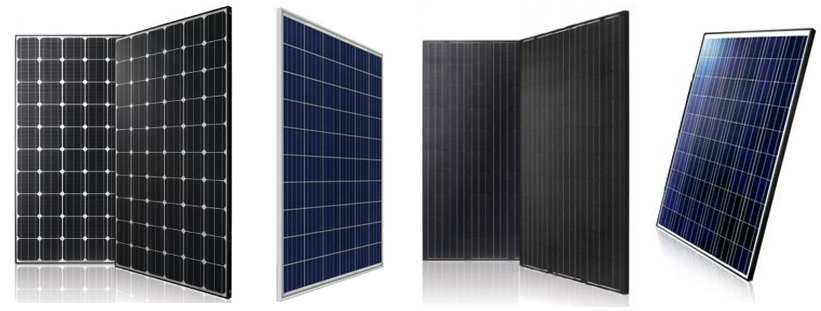
There is also a difference in how the modules are mounted. There are a few main options for this:
On-roof – this is where the panels are mounted above an existing roof covering. This is by far the most common type of mounting system for domestic and commercial installations in the UK.
In-roof – sometimes know as ‘roof-integrated’ this is where the pv modules sit inside the roof similar to a skylight. This is popular in new builds. It can be done as a retrofit on existing properties but the cost is significantly more than on-roof because of the additional material and time required.
Flat roof systems – there are a number of different types of flat roof mounting system suitable for different types of flat roof
Ground mount systems
Solar tiles and slates - there are now a few manufacturer making solar tiles that can be used instead of normal tiles or slates. Aesthetically these can be very discreet.
BIPV – Building Integrated Photovoltaics – This is where solar PV cells are integrated into a buildings fabric in some way, for example in cladding or replacing glass sections on outside walls.
For more information on the aesthetics of solar panels read our article 'Solar panel aesthetics'.

